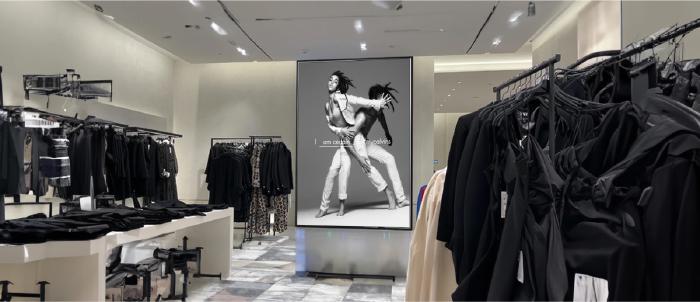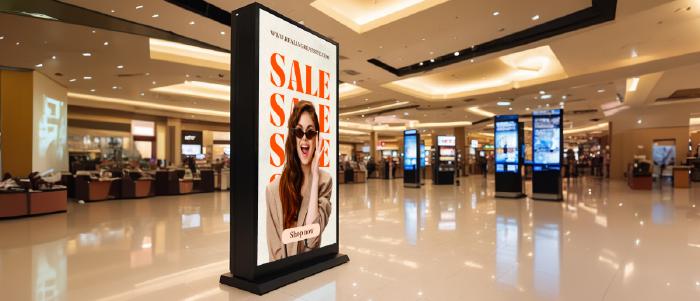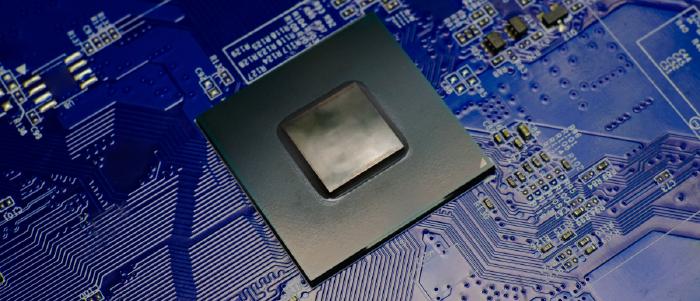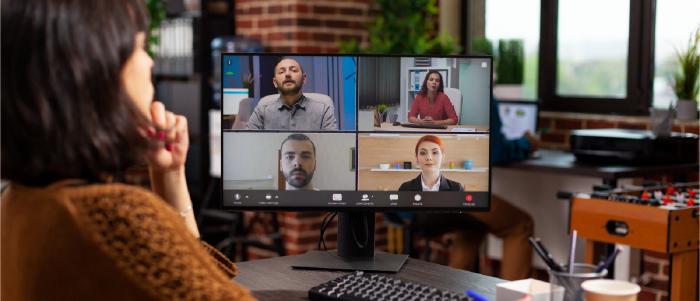
Jul 5 2024
6 min read


Apr
How do you create a display that’s impossible to ignore?
Imagine customers interacting with holographic advertisements that showcase products in 3D. Or a fashion show projected onto your storefront window, where viewers can vote for their favorite outfit with a simple tap.
These experiences have one thing in common: Augmented Reality (AR).
AR layers the digital world onto the real one, blurring the lines between what customers see and what you can make them experience.
But how will it impact the future of digital signage? What are its use cases? And are augmented reality signs a feasible option for you? In this article, we’ll answer all your questions (and more!). Let’s dive in.
We all remember Pokémon Go, right? The game was such a novelty because players could see Pokémon appear in their everyday world. And that’s what AR looks like in action.
The concept isn’t new, but tech giants are increasingly recognizing its potential. For example, Apple unveiled its highly anticipated Apple Vision Pro—a mixed-reality headset that combines the real world with computer-generated elements.
Augmented reality signs will revolutionize the way we interact with the world around us. It can:
Enhance information access: Overlay real-time data, directions, or translations onto your surroundings.
Boost visualization: See 3D models of furniture in your living room or preview design changes directly on a physical object.
Break down communication barriers: Collaborate virtually with colleagues across the globe in shared AR environments.
On the other hand, VR displays create a completely immersive virtual environment. That means you can watch the Northern Lights or climb a mountain right from your living room.

These displays use a headset with built-in screens that completely cover your eyes, blocking out the real world. They can also incorporate motion tracking to allow users to interact with the virtual environment by moving their heads and bodies.
Think about the cosmetics section in department stores or malls. It’s usually lined with signs displaying colorful and dynamic makeup ads. While these signs demonstrate the products in action and offer color swatches, they don’t tell customers whether the makeup would look good on them.
Now, let’s add AR digital signage to the scenario.
Customers approach the display and see a variety of makeup looks on different models. Through a touch interface or a phone app connected to the display, they can virtually “try on” different makeup combinations. They experiment with lipstick shades, eyeshadow colors, and even apply virtual blush or eyeliner.
This way, customers can actually see how the makeup looks on their own skin tone and facial features in real time (using the phone’s camera). Not only will this increase customer satisfaction, but it can also lead to higher sales. 8 ideas for augmented reality signs While the general consensus is that augmented reality signs aren’t mainstream, many brands are still using them to create engaging experiences.
For example, Lynx Cologne transformed train stations in London and Birmingham for two days in a creative marketing stunt using AR. Commuters, who stood on signs that read’ Look up, ’ interacted with virtual angels that appeared on a giant digital screen.
But apart from advertising, where else can we use AR displays? Here are 8 ideas:
Gamification is a great way to engage customers while encouraging them to buy more. Starbucks does a great job of this with its loyalty program. You get a star for every dollar spent — they help unlock rewards like free customizations, birthday drinks, and more.
Adding AR to a similar gamification experience can significantly amp up the engagement factor. You can create product-based games where customers earn points and unlock rewards by scanning items and answering trivia questions related to your brand.
Integrate AR into your digital signage to conduct scavenger hunts. Customers can use their phones to find hidden virtual objects throughout the store, unlocking discounts or special offers. This playful approach not only entertains but also encourages exploration and product discovery.
By using AR to provide product information, your customers can easily access customer reviews, product comparisons, and instructional videos. All they need to do is hover their phone camera over your digital display to swipe through various products and watch instructional videos demonstrating its functionality.
Static window displays are designed to grab attention, but what if you could make them better? AR helps add a layer of interactivity that customers love. This is because they can virtually scroll through products and customize them with different colors, materials, or even monograms.
This creates a more engaging experience, strengthening the brand’s connection. It also increases their chances of entering the store to explore further.
Wouldn’t it be great if you could try on dozens of clothes in seconds — without even entering a changing room? Lily, a Chinese womenswear brand, used this idea to set up a creative pop-up store at a metro station in Shanghai.
They used two interactive screens that allowed passengers to try on different clothes by taking a selfie and inserting their height and weight. Here’s how it worked:
Another way to do this is to ask customers to scan an item’s barcode, and the mirror will display a realistic 3D projection of that item on their body. This way, customers can experiment with different colors, sizes, and styles without physically changing clothes.
With AR, teachers can tailor lessons to individual learning styles. Students can access additional information or interactive exercises based on their needs, creating a more personalized and effective learning journey.
Augmented reality signs help break down complex concepts into visually stimulating experiences that enhance understanding and retention. Students can dissect virtual organisms with them instead of staring at flat pictures. They can rotate it, zoom in on different organs, and see how everything works together.
They can also explore 3D models of historical landmarks in history lessons, or the human body with interactive anatomical overlays in anatomy courses.
Architects and engineers use AR to visualize their designs in real-world environments before construction begins. This helps them identify potential problems much earlier. It also enhances collaboration with stakeholders by offering a shared 3D perspective.
Warehouse workers can use augmented reality signs to project product information and locations directly onto shelves, improving picking and packing accuracy and reducing time spent searching for items.
AR has the power to transform static displays into dynamic, interactive experiences that are shaped by your brand. From interactive museum exhibits that reanimate ancient civilizations to AR product customizers that let customers craft their dream purchases, this technology is shattering boundaries and unlocking new realms of creativity.
Whether you want to use AR to enhance learning or gamify customer experiences, our team at Pickcel can create personalized solutions just for you! Reach out to us today.
Take complete control of what you show on your digital signage & how you show it.
Start Free Trial Schedule My Demo
Jul 5 2024
6 min read

Jul 1 2024
7 min read

Jun 28 2024
5 min read

Jun 7 2024
7 min read